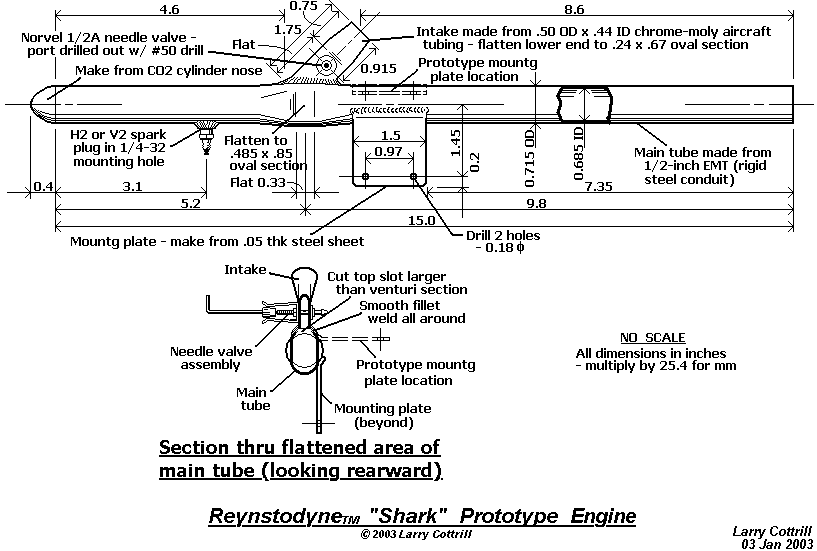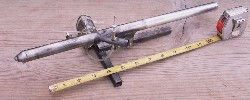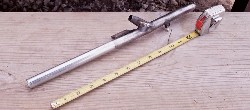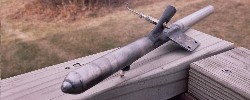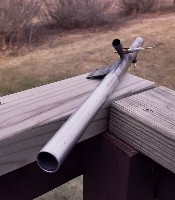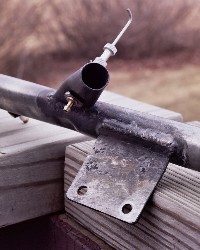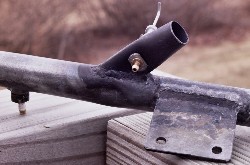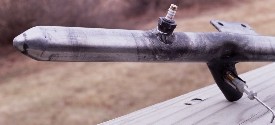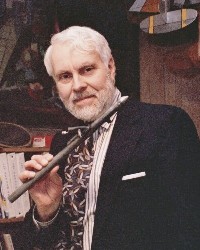_____________________________________________________
Note from the Editor:
In this feature of each issue, we'll feature one of my own
designs from our Gallery of Hopeful Monsters. These
will generally be jet engines or related equipment that are
PROPOSED designs that are as yet untested and unproven --
BUILD AT YOUR OWN RISK !!! No full-size plans, scale prints
or detail drawings, other than what we show here, are available.
Also, since these are usually just proposed designs that we haven't
even built ourselves, we offer almost no technical information --
these are definitely for advanced experimenters who are used to
working out the fine points on their own!
So, these designs are mostly presented to give you something to
think about, although advanced hobbyists can try to build them
and get them to run. Let us know if you have any amazing
successes to report!
One of my latest designs is the Reynstodyne(TM) Shark(TM) engine, so
called because of the rearward-sloping 'fin' intake. In this case,
the prototype actually has been built [as shown in the photos
below, with comments], but preliminary testing has not been very
conclusive [testing was cut short because my starting air
compressor bombed -- I now have a replacement, but it's been too
cold and wintery for the last couple of weeks to stand around
outside for testing].
A final note is that my friend Ben Brockert suggested lengthening
the tailpipe so it would be somewhat MORE than twice the length
of the front chamber. This opinion was based on his reading of the
great work of F. H. Reynst. I took his advice, not by lengthening the
tailpipe, but by shortening the chamber approximately 3/4 inch (18mm)
thus moving in the direction of being more compact, rather than
significantly longer. One of these days, it's going to warm up a little,
and then I'll find out what we've got here!
Stay tuned ... - Larry Cottrill
_____________________________________________________
The ReynstodyneTM 'Shark' tiny valveless pulsejet design
by Larry Cottrill
Copyright 2003 Larry Cottrill
REYNSTODYNETM 'SHARK' ENGINE
The original shark prototype drawing, as disclosed on 03 January 2003. In a recent modification,
the length of the ignition chamber has been reduced by taking out .75 inch in front of the
spark plug.
Drawing Copyright 2003 Cottrill Cyclodyne Corporation
Original disclosure 01/03/2003 on Kenneth Moller's Valveless Pulsejet Forum,
as follows:
[
Well, here's the latest -- the Reynstodyne(TM) 'Shark'(TM) prototype engine:
The drawing should be self-explanatory, but a couple of details bear a bit
more explanation:
The idea of the 'sharkfin' intake is that the easiest path provided for entering
air will be forward into the chamber. This does not mean that significant air
won't be diverted rearward to fill in the tailpipe behind the hot gas 'piston'
as it exits. The way you attach the intake venturi to the pipe is important.
You cut the slot in the top of the pipe MUCH larger than the cut off base of
the flattened tube venturi (so the venturi would actually fall down in!). Then,
you clamp the intake in place 'hovering' over the slot and tack weld in a couple
of spots by 'bridging' across the gap, then bend it around the tack welds a
little til it's lined up true with the tube centerline. Then, tack weld in a couple
more spots, and finish weld all around, again 'bridging' your weld across the
gap. What you end up with is a fairly smooth flow transition on the inside
where it counts. That sounds a lot trickier than it is -- the gap is only a
sixteenth of an inch or so, all around. It took about 20 minutes to do the whole
job. You make the intakes two at a time by flattening the middle of a short
piece of tubing to the 'just right' width, and then cut diagonally across the flat
with the jeweler's saw. Then, drill through for the needle valve --
simplicity itself.
The drawing shows the mounting plate as it would be on a production engine
(fin to the top) -- for testing purposes, I placed it on mine so the fin would be
on the left side and the plug on the right. That's why there are those 'ghost
images' of the mount in the 'prototype location'. Location and orientation of
this plate should be completely non-critical, except that I wouldn't put it up
front on the chamber somewhere because of its potential for heavy heat
conduction.
My insistence on having the sparkplug where the incoming carbureted air/fuel
stream washes over it may not be optimal -- it's just located that way because
I thought it would make for easy starting. Once the engine's running, the plug
should mean nothing, of course.
I did not include a football filler type air pipe aimed across the needle valve
and down the throat, though I may end up needing to add one. I decided that
I'd try starting the Shark either by blowing air in with a hand-held miniature
nozzle, or try just spraying fuel in from a pressure can, via a tiny tube
extended down through the intake throat! Based on my earlier experimentation,
the needle valve will probably need to be way open (5 or 6 full turns) for good
starting.
]
Recent design/change notes on this design:
- Current prototype has had the front chamber reduced in length by .75 inch
(18mm) from the drawing dimensions shown, to make certain the chamber
length is LESS THAN 1/2 the tailpipe length [ref: F. H. Reynst]
- It is probable that location of the sparkplug in the bottom of the chamber
is not good design, since it makes the plug potentially susceptible to fuel
flooding during starting; side location is probably better
- 'Football filler' starting air pipe was added to the intake to aim starting
air properly across the fuel port of the needle valve assembly; this resulted
in more reliable ignition during starting attempts
Prototype Engine Photos:
A COMPACT VALVELESS PULSEJET DESIGN
These shots show the completed SharkTM prototype engine, laid out by a tape rule (inches) -
original overall length as shown here was just over 15 inches [.4 m]. It has since been reduced
by .75 inch [18mm]. In the upper photo, the engine is shown mounted on the test frame, with
fuel tank [just behind engine tube] connected to the needle valve body.
Photos Copyright 2003 Cottrill Cyclodyne Corporation
THE SHARKTM IN PERSPECTIVE
The engine seen from the nose end [upper photo] and exhaust end [lower photo]. Note the
spark plug ahead of and opposite to the 'shark fin' intake tube. In the lower shot, the rim
of the rearward-facing intake opening is visible above the needle valve assembly.
Photos Copyright 2003 Cottrill Cyclodyne Corporation
NOZZLE ZONE AND INTAKE TUBE DETAILS
These shots show the slightly pinched nozzle area between the ignition chamber and tailpipe,
and details of how the flattened area of the intake tube is blended into the main tube in this
region. The needle valve body penetrates the intake tube through this narrow section. [An air
tube for starting was added later to the lower edge of the intake rim.]
Photos Copyright 2003 Cottrill Cyclodyne Corporation
IGNITION CHAMBER AND PLUG MOUNT DETAIL
Inverting the engine allows the plug mount and its relationship to the intake tube to be clearly
seen. During starting, the forced draft of fuel/air mixture will cross the tube and flow forward
down the side around the end of the spark plug. The plug mount is sufficiently thick that only the
spark electrodes of this long-reach plug are allowed to clutter the inside wall of the tube.
Photo Copyright 2003 Cottrill Cyclodyne Corporation
Theory of Operation
The SharkTM is what I refer to as a 'Reynst pattern' engine. What I mean
by this is a pulse combustion engine where the ignition chamber is
separated from the tailpipe by an air inlet, and where the front of the
chamber is closed and all breathing of the chamber to support combustion
takes place at its rear opening after expulsion of the explosion product
gases. This definition does not necessarily mean that all the air is taken
in from the gap [i.e. with none of it coming back in through the tailpipe], but
in fact that may actually be the case in such designs.
'Reynst pattern' devices are extremely efficient burners; in fact, F. H. Reynst
developed his famous 'Reynst pot' not as a propulsion device but rather as an
industrial burner for special heating applications. As such, the 'pot' itself
is not optimized for ejected mass at high velocity, but rather for efficiently
burning fuel and recovering the combustion energy as heat. However, efficient
combustion is one primary concern for a practical jet powerplant. It is hoped
that the design shown here will eject mass rapidly enough for good propulsive
force [thrust] while retaining a reasonable semblance to Reynst's high
efficiency mode of operation.
A non-mathematical description of a single operational cycle is as follows:
After the fuel/air charge explodes in the front end of the ignition chamber,
the extremely sudden pressure rise causes a rapid expansion which
compresses the air [or residual exhaust gas] in the rear of the chamber
and begins to accelerate this gas mass rearward.
As the gas mass accelerates rearward, the portion of gas that started
out inside the chamber passes through the relatively narrow nozzle zone,
which locally increases its rearward velocity and drops its static pressure.
The lowered static pressure prevents the gas from being ejected outward
through the intake port, since the outside air is at normal pressure. Thus,
beginning at this point in the cycle, the chamber is effectively 'valved
off' from the outside air and fuel. For all practical purposes, the exhaust
flow is not influenced by the presence of the air intake, and the engine
behaves as a continuous pipe closed at one end for this part of the
cycle.
As combustion within the rear of the moving gas mass continues, the gas
slows and regains static pressure as it exits the nozzle zone. Expansion
continues to drive the gas rearward, and the 'leading edge' of the gas mass
begins to exit through the tail end of the pipe.
At some point, practically all the explosion energy has been transferred to
the gas mass as rearward momentum [though a significant fraction has
been lost as heat to the metal engine shell]. At this point, the gas mass
acts as a 'piston' pulling the very low-density residue in the chamber
into a condition of 'overexpansion'; that is, the static pressure in the
chamber begins to drop.
Eventually, the gas mass has moved so far rearward that the overexpanded
area occupies the entire chamber and reaches into the nozzle zone and
covers the inside face of the intake tube. Because the overexpanded gas
has low static pressure, the outside air pressure begins pushing the air
in the intake tube inward into the interior of the engine. From this point
in the cycle, the chamber is "valved on" to fresh air and fuel! As air flows
in, it will be replaced by fresh air from the outside beyond the outer intake
rim. The behavior of the engine is now that of a short low-pressure
chamber open to standard pressure air via a narrow opening.
The whole air column in the intake is now in motion, and flow will continue
until the pressures again equalize; this will take a while because of the
volume of the chamber. Because the lower zone of the intake pipe is
flattened to a much smaller internal cross-section than the outer intake rim,
the air is accelerated to a much higher velocity in this region, and the static
pressure drops. This means that the liquid fuel present at the fuel port in
the needle valve body will be drawn into the airflow, since the fuel external
to the valve is at more-or-less outside air pressure. Because of the shear
and turbulence effects on the air as it passes around the needle valve body,
the fuel drawn in is immediately atomized, so it will be rapidly evaporated
into the air stream as it enters the engine.
As air/fuel mixture pours in, it is routed by the geometry of the intake pipe,
the nozzle and the chamber forward, deeper into the chamber. At the same
time, the main gas mass in the tailpipe continues outward, but some of its
'trailing edge' combustion is slowed and eventually pulled forward through
the nozzle zone into the chamber. Eventually, the material in the chamber
has sufficient density and pressure, and the proper fuel/air ratio to form an
explosive mixture that can be ignited.
The exhaust gas mass in the tailpipe is also influenced by the pressure
difference that has been developed. This pressure difference acts as a
force in the forward direction, and the exhaust mass as a whole starts to
slow down in response to this force. Whether this mass actually undergoes
reversal and begins pouring back into the chamber through the nozzle
depends entirely on how long it takes for standard pressure to be regained
in the chamber. At any rate, to some extent, the engine now behaves as
a short low-pressure chamber open to standard air pressure via a small
port and below-standard but increasing pressure gas via a significantly
larger opening.
The accumulated mixture, reaching approximately the static pressure of the
outside air, ignites explosively to begin the next cycle of operation.
[It is not perfectly understood whether ignition happens because of the
recycled gases pulled back in from the tailpipe or simply because of residual
"free radicals" in the chamber. Once the combustion chamber walls attain
high temperature, this may also affect the precise instant of ignition.
However, the composition, pressure and density of the mixture are probably
the biggest determining factors in the precise timing of the explosion.]
The complete cycle described above would take approximately 3 milliseconds,
with a pulse frequency of about 330 cycles/second, with the engine dimensions
shown in the drawing.
If you decide to try to build a working model of this experimental design,
make sure you get plenty of photos and email them to us in GIF or JPG
format to display in a future issue [we will make the final decision
as to the best ones to use, and we'll show your name as a photo credit.]
And, why not try writing an article about building and firing it? We
don't pay for articles, but we'd be glad to help you "get your name in
print". Also, any author whose article we accept gets a free ad for your
e-business or Web site! Naturally, we will provide editing as needed for
publication in readable US English.
- Larry Cottrill
|
